A Mid Cycle Marketing Email targets customers mid-way through their buying journey. It aims to nurture leads and boost engagement.
Mid Cycle Marketing Emails play a crucial role in maintaining customer interest. These emails keep potential customers engaged, providing valuable information that encourages them to move further down the sales funnel. They can include product updates, educational content, and personalized recommendations.
Businesses use these emails to build trust and deepen relationships with their audience. Effective Mid Cycle Marketing Emails balance informative content with subtle promotional messages. By offering value and addressing customer needs, these emails help convert leads into loyal customers. Crafting engaging and relevant mid-cycle emails can significantly impact your marketing success.
Introduction To Mid Cycle Marketing Emails
Marketing emails are crucial in connecting with your audience. Among various types, Mid Cycle Marketing Emails play a unique role. They fall between initial contact and final sales push.
Definition
A Mid Cycle Marketing Email is sent mid-way through the customer journey. These emails help nurture leads and keep potential buyers engaged.
These emails are neither the first touchpoint nor the closing pitch. They aim to provide valuable content and build trust.
Importance
Mid Cycle Marketing Emails have several key benefits:
- Engagement: Keep your audience interested in your products.
- Trust Building: Offer valuable information to build trust.
- Lead Nurturing: Guide potential buyers toward a purchase decision.
Let’s break down why these emails are essential:
| Benefit | Description |
|---|---|
| Engagement | Maintain your audience’s interest over time. |
| Trust Building | Provide useful content to build credibility. |
| Lead Nurturing | Move leads closer to a purchasing decision. |
These emails ensure your brand stays top-of-mind. They help you connect better with your audience.
Crafting The Perfect Email
Creating a mid cycle marketing email can be a game-changer. The perfect email grabs attention and drives engagement. Below, we explore key elements to achieve this.
Subject Line Tips
The subject line is the first thing your audience sees. It should be engaging and relevant.
- Keep it short and sweet: Aim for 6-10 words.
- Use action words: Encourage readers to open the email.
- Include numbers: Numbers can attract attention.
- Avoid spammy words: Words like “free” or “buy now” can trigger spam filters.
Personalization Techniques
Personalization makes your email feel special. It can significantly boost engagement.
- Use the recipient’s name: Start with “Hi [Name]”.
- Segment your audience: Send relevant content to different groups.
- Leverage past behavior: Mention products they viewed or bought.
- Dynamic content: Show different content based on user data.
Incorporating these tips can help you craft the perfect mid cycle marketing email. A well-crafted email can make a substantial difference in your marketing efforts.
Timing And Frequency
Understanding the timing and frequency of your mid-cycle marketing emails is crucial. It can make a big difference in how your audience engages with your content.
Optimal Timing
The best time to send your mid-cycle marketing emails depends on your audience. Generally, mid-week days like Tuesday and Thursday work well. Avoid weekends as people are less likely to check emails.
Send emails during work hours for higher open rates. Early morning or late afternoon times are often the best.
Balancing Frequency
Finding the right frequency for your mid-cycle marketing emails is key. You want to stay on your audience’s mind without annoying them. Aim for one or two emails per month.
Don’t flood their inbox. Instead, focus on valuable content that keeps them engaged. Always monitor your email metrics. Adjust the frequency based on open rates and feedback.
| Day | Time | Frequency |
|---|---|---|
| Tuesday | 9 AM – 11 AM | Once a Month |
| Thursday | 2 PM – 4 PM | Once a Month |
Use this schedule to plan your mid-cycle emails. Adjust it based on your audience’s behavior.
Content Strategies
Creating a Mid Cycle Marketing Email involves strategic planning. The goal is to re-engage your audience. Use effective content strategies to capture attention. Focus on elements like engaging copy and visual appeal. This section will delve into these strategies.
Engaging Copy
Writing engaging copy is crucial. Your text should be concise and clear. Use short sentences for better readability. Include a compelling subject line to grab attention. Personalize your email to connect with the reader. Here are some tips:
- Start with a strong subject line.
- Personalize the greeting.
- Use bullet points for key information.
- Include a clear call to action.
- Keep paragraphs short and focused.
Visual Elements
Visual elements make your email more appealing. Use images, infographics, and videos. They help break up text and maintain interest. Ensure your visuals are relevant and high-quality. Consider these elements:
| Visual Element | Purpose |
|---|---|
| Images | Highlight products or services |
| Infographics | Present data and statistics |
| Videos | Engage with dynamic content |
Ensure all visuals are mobile-friendly. They should load quickly and display correctly. This enhances the user experience and keeps readers engaged.
Segmentation And Targeting
Understanding Segmentation and Targeting is crucial for effective mid-cycle marketing emails. Proper segmentation and targeting ensure your emails reach the right audience. This enhances engagement and drives conversions.
Audience Segmentation
Audience segmentation divides your email list into smaller groups. These groups share common characteristics. Segmenting your audience allows for more personalized content. Personalized emails perform better and increase engagement.
Here are some ways to segment your audience:
- Demographics: Age, gender, income, education level.
- Geographics: Location, city, country.
- Psychographics: Interests, hobbies, values.
- Behavioral: Purchase history, website interactions, email engagement.
By understanding these segments, you can craft emails that resonate with each group.
Behavioral Targeting
Behavioral targeting focuses on users’ actions and behaviors. It helps in delivering more relevant content. This approach increases the chances of conversion.
Some examples of behavioral targeting include:
- Purchase history: Suggest products based on past purchases.
- Email engagement: Target users who opened your previous emails.
- Website behavior: Send emails based on pages visited or time spent on site.
Behavioral targeting allows for timely and relevant communication. This keeps your audience engaged and interested.
| Segmentation Type | Examples |
|---|---|
| Demographics | Age, gender, income |
| Geographics | City, country |
| Psychographics | Interests, hobbies |
| Behavioral | Purchase history, website interactions |
Utilizing segmentation and targeting ensures that your mid-cycle marketing emails are effective and engaging.

Credit: www.campaignmonitor.com
Analyzing Performance
Analyzing performance is crucial for understanding the impact of your mid-cycle marketing emails. This helps in refining strategies and ensuring better engagement. By focusing on key metrics and A/B testing, you can optimize your emails for maximum effectiveness.
Key Metrics
Tracking key metrics is essential for measuring the success of your email campaigns. Some of the important metrics include:
- Open Rate: The percentage of recipients who opened your email.
- Click-Through Rate (CTR): The percentage of recipients who clicked on a link within the email.
- Conversion Rate: The percentage of recipients who completed a desired action, such as making a purchase.
- Bounce Rate: The percentage of emails that could not be delivered.
- Unsubscribe Rate: The percentage of recipients who opted out of your mailing list.
A/b Testing
A/B testing is a powerful method for optimizing your email campaigns. It involves sending two variations of an email to different segments of your audience. This helps you determine which version performs better. Here are some elements you can test:
- Subject Lines: Test different subject lines to see which one gets more opens.
- Call to Action (CTA): Experiment with different CTAs to find the most effective one.
- Email Content: Compare different types of content to see which resonates more with your audience.
- Sending Time: Test different times of the day or week to find the optimal sending time.
- Personalization: Test the impact of personalized content versus generic content.
By focusing on these key metrics and utilizing A/B testing, you can significantly improve the performance of your mid-cycle marketing emails.
Avoiding Common Pitfalls
Sending a mid-cycle marketing email can drive customer engagement. But there are common pitfalls to avoid. Let’s explore how to navigate these challenges effectively.
Spam Filters
Spam filters can block your emails. To avoid this, follow these tips:
- Use a clean email list: Ensure your list contains active subscribers.
- Avoid spammy language: Words like “Free” and “Buy now” trigger spam filters.
- Authenticate your emails: Use SPF, DKIM, and DMARC records to verify your email.
- Monitor your email reputation: Use tools to check your sender score regularly.
Following these steps reduces the risk of your emails landing in the spam folder.
Over-communication
Over-communicating can annoy your subscribers. This leads to unsubscribes and complaints. Here’s how to strike the right balance:
- Segment your audience: Tailor your messages to specific groups.
- Set a frequency cap: Limit the number of emails per week.
- Offer preferences: Let subscribers choose how often they receive emails.
- Monitor engagement metrics: Track open and click rates to gauge interest.
By managing communication frequency, you maintain subscriber interest and reduce churn.
Case Studies
Mid Cycle Marketing Emails can boost engagement and sales. These case studies show how effective they can be. Learn from real examples and see what worked.
Success Stories
Several companies have seen huge success with Mid Cycle Marketing Emails. Here are some standout examples:
| Company | Strategy | Results |
|---|---|---|
| TechCorp | Personalized product recommendations | 35% increase in sales |
| FashionHub | Exclusive mid-season discounts | 50% boost in engagement |
| BookWorld | New release alerts | 20% higher click-through rates |
Lessons Learned
From these case studies, we can learn several key points:
- Personalization works wonders. Tailored content grabs attention.
- Timing matters. Send emails when engagement is likely.
- Exclusive offers drive action. People love special deals.
Each company had its own strategy, but some common themes emerged. Personalization and timing were crucial for success.
Focus on your audience’s needs and preferences. This makes your emails more relevant and impactful.
Future Trends
Mid-cycle marketing emails are evolving rapidly. Businesses seek to enhance engagement and conversion rates. Let’s explore the future trends shaping this landscape.
AI In Email Marketing
AI is transforming email marketing strategies. It allows for personalization and automation. Marketers can now send the right message at the right time.
- AI helps in segmenting email lists efficiently.
- It predicts customer behavior.
- AI optimizes email content for better engagement.
Using AI, businesses can analyze customer data. They can then craft personalized emails. This increases open and click-through rates.
Interactive Emails
Interactive emails are becoming more popular. They engage users directly within the email. This reduces the need to navigate away from the inbox.
| Feature | Benefit |
|---|---|
| Polls and Surveys | Gather feedback instantly. |
| Clickable Images | Enhance visual engagement. |
| Embedded Videos | Provide richer content experiences. |
Interactive elements like polls, clickable images, and videos make emails more engaging. This leads to higher customer interaction and satisfaction.

Credit: myoneblog.com
Frequently Asked Questions
What Is A Mid Cycle Marketing Email?
A mid cycle marketing email is sent during the customer journey. It aims to re-engage and provide relevant updates or offers.
Why Are Mid Cycle Marketing Emails Important?
They help maintain customer engagement and boost retention. These emails keep your brand top-of-mind between major campaigns.
How To Create An Effective Mid Cycle Marketing Email?
Focus on personalization and relevance. Use customer data to tailor content and offers that resonate with their interests.
What Should Be Included In A Mid Cycle Marketing Email?
Include personalized content, relevant offers, and a clear call-to-action. Make sure the email is engaging and visually appealing.
Conclusion
Crafting a mid-cycle marketing email can boost engagement and drive sales. It’s a strategic tool for nurturing leads. Consistent, relevant communication keeps your audience interested. Implementing this approach can enhance your marketing efforts. Start leveraging mid-cycle emails to see improved customer relationships and conversions.






